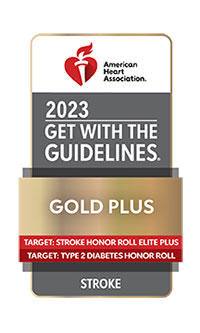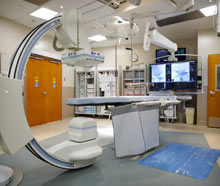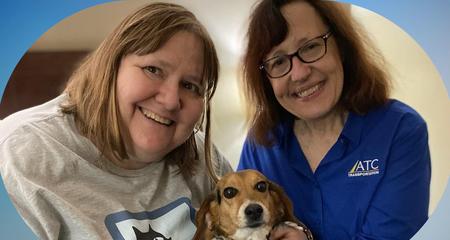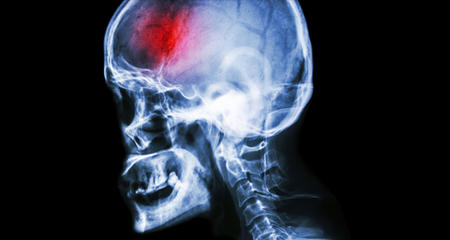The Froedtert & MCW Comprehensive Stroke Center treated nearly 893 patients in 2022.
While hospitalized, patients’ immediate stroke symptoms were treated and diagnostic tests performed to determine the cause or source of the stroke. The goal is to prevent another stroke or neurovascular event.
Our expert team of specialists provides comprehensive stroke care, including identifying and managing secondary health issues. They are efficient in identifying and managing all associated neurovascular risk factors.
Get With The Guidelines® Awards

For 2023, the Froedtert Hospital Comprehensive Stroke Center and the Primary Stroke Centers at Froedtert Menomonee Falls Hospital and Froedtert West Bend Hospital all earned the Get With The Guidelines® — Stroke GOLD PLUS with Honor Roll Elite Plus and Type 2 Diabetes Honor Roll Award, (the highest level of recognition possible for a single, continuous 24-month period) from the American Heart Association Get With the Guidelines Program. The award recognizes commitment and success in implementing the highest standard of stroke care. See how we measure up according to these guidelines.
Dedicated to improving hospital-based stroke care, Get With the Guidelines® (GWTG)-Stroke was created in 2003 by the American Heart Association/American Stroke Association and collaborates with the Joint Commission. The program measures a hospital’s adherence to the latest scientific treatment guidelines. Since 2003, nearly 4000 hospitals have added millions of patient records to the GWTG-Stroke database. Multiple studies based on these records show the impact this program has had on improving patient outcomes.
The Froedtert & the Medical College of Wisconsin Stroke Center has two high level national distinctions.
- Comprehensive Stroke Center Certification
We are one of less than 10% of hospitals nationwide awarded the highest level of recognition dually awarded by The Joint Commission and the American Heart Association/American Stroke Association. - Gold Plus Target Stroke Honor Roll Elite Plus
The highest GWTG-Stroke quality and achievement award for 24 straight months of consistent high performance which recognizes our dedication and success in achieving the highest standard of stroke care in each of seven nationally accepted core quality measures.
-
Get With the Guidelines - Stroke Measures
The Get With The Guidelines (GWTG) — Stroke Measures are as follows:
GWTG Achievement Measures
- IV thrombolysis arrive by 3.5 hours, treat by 4.5 hours: Percent of acute ischemic stroke patients who arrive at the hospital within 210 minutes (3.5 hours) of time last known well and for who thrombolysis was initiated at this hospital within 270 minutes (4.5 hours) of time last known well. Corresponding measure available for inpatient stroke cases.
- Early antithrombotics: Percent of patients with ischemic stroke or TIA who receive antithrombotic therapy by the end of the hospital day two. Corresponding measures available for observation status only and inpatient stroke cases.
- VTE prophylaxis: Percent of patient with ischemic stroke, hemorrhagic stroke or stroke not otherwise specified who receive VTE prophylaxis the day of or the day after hospital admission.
- Antithrombotics: Percent of patients with ischemic stroke or TIA prescribed antithrombotic therapy at discharge. Corresponding measures available for observation status only and inpatient stroke cases.
- Anticoagulation for AFib/AFlutter: Percent of patients with ischemic stroke or TIA with atrial fibrillation/flutter discharged on anticoagulation therapy/. Corresponding measures available for observation status only and inpatient stroke cases.
- Smoking cessation: Percent of patients with ischemic or hemorrhagic stroke, or TIA with a history of smoking cigarettes, who are, or whose caregivers are, given smoking cessation advice or counseling during hospital stay. Corresponding measures available for observation status only and inpatient stroke cases.
- Intensive statin: Percent of ischemic stroke or TIA patients who are discharged on intensive statin therapy. Corresponding measures available for observation status only as well as inpatient stroke cases.
GWTG Quality Measures
- Dysphagia Screening (AHASTR8)
- Stroke Education (AHASTR12)
- Assessed for Rehabilitation (AHASTR11)
- LDL Documented (AHASTR9)
- NIHSS Reported (AHASTR10)
- Door to Needle ≤ 60 minutes (AHASTR13)
Target Stroke Recognition
- Target: Stroke Honor Roll — 75% of applicable patients experiencing door-to-needle times of 60 minutes or less.
- Target: Stroke Honor Roll Elite — 85% of applicable patients experiencing door-to-needle times of 60 minutes or less.
- Target: Stroke Honor Roll Elite Plus — 75% of applicable patients experiencing door-to-needle times of 45 minutes or less and 50% of applicable patients experiencing door-to-needle times of 30 minutes or less.
- Target: Stroke Honor Roll Advanced Therapy — 50% of applicable patients experiencing door-to-needle times of 90 minutes or less for direct arriving patients and 60 minutes or less for transfer patients (within six hours or 24 hours).
Target Type 2 Diabetes in Stroke
- IV Thrombolytics Arrive by 3.5 hours/Treat by 4.5 hours
- Early Antithrombotics for Patients With Diabetes
- VTE Prophylaxis
- Antithrombotic Prescribed at Discharge
- Anticoagulation Prescribed for AFib/AFlutter at Discharge
- Smoking Cessation
- Intensive Statin Prescribed at Discharge
- Diabetes Treatment
- Therapeutic Lifestuyle Changes (TLC) Recommendations at Discharge
- Antihyperglycemic Medication With Proven CVD Benefit
Used with permission from heart.org.
BE FAST — When Minutes Count
The Froedtert Acute Stroke Team (FAST) is available 24 hours a day, seven days a week. This acute response team provides stroke patients with rapid access to diagnosis and treatment. Stroke neurologists, critical care neurologists, neuroradiologists, neurosurgeons, interventionists, emergency medicine physicians and nurse specialists work around the clock to treat stroke. More than 1 in 4 acute ischemic stroke patients receive quick intervention with either IV thrombolytic and/or mechanical thrombectomy shortly after arrival.
Clot-Busting Drugs and Endovascular Therapy
Studies show that thrombolytic drugs, or clot-busters, may effectively stop strokes and improve patient outcomes if specialists trained in giving the drugs are immediately available. All FAST doctors are trained to administer clot-busters and have been successfully using them since their approval in 1996. Some of these miracle drugs need to be administered intravenously within the first three hours of the onset of symptoms (up to 4.5 hours for some patients). It’s another reason to be fast when stroke symptoms occur.
We consistently treat a high percentage of stroke patients with stroke-stopping thrombolytic therapy. If patients arrive at the hospital too late for effective use of IV thrombolytic or if IV thrombolytic is not appropriate for them, physicians may use neuro-interventional procedures (thrombectomy) to remove the clot. Endovascular procedures are those performed from inside the blood vessel. A device can be used to suction or trap the clot and remove it, or, if needed, the thrombolytic agent can be injected directly on the clot.
Comprehensive Stroke Center Certification
 Froedtert Hospital has been recognized by The Joint Commission and the American Heart Association/American Stroke Association and has earned Comprehensive Stroke Center Certification. This makes the program part of an elite group of providers focused on offering the most advanced complex stroke care in the region.
Froedtert Hospital has been recognized by The Joint Commission and the American Heart Association/American Stroke Association and has earned Comprehensive Stroke Center Certification. This makes the program part of an elite group of providers focused on offering the most advanced complex stroke care in the region.
In the fall of 2012, The Joint Commission established the Comprehensive Stroke Center certification to "recognize the significant differences in resources, staff and training that are necessary for the treatment of complex stroke cases" at an advanced level by proving the "specialized care that can lead to better outcomes." Froedtert & MCW received their fourth Comprehensive Stroke Center Designation in 2019.
Froedtert Hospital became one of the first organizations in the state and country to achieve Comprehensive Stroke Center and has maintained this certification ongoing. Prior to offering this higher level of advanced stroke certification, The Joint Commission had offered Primary Stroke Center certification which Froedtert hospital has earned and maintained since 2004.
According to The Joint Commission, by achieving advanced certification, Froedtert & the Medical College have demonstrated their commitment to the highest level of care for its stroke patients. Certification is a voluntary process. The Joint Commission commended Froedtert & the Medical College of Wisconsin for successfully undertaking the challenge to elevate its standard of care and instill confidence in the community it serves.
Certification Demonstrates Commitment to High Caliber Stroke Care

In our angiography suite, detailed images of blood vessels in the neck and brain are produced to help physicians locate blockages, aneurysms and other abnormalities.
As a Certified Comprehensive Stroke Center, the Froedtert & the Medical College program demonstrates its ability to provide care from a multi-disciplinary team. The team includes neurologists, neuro-interventionalists, emergency department specialists, radiologists, neurosurgeons, nurses, therapists, pharmacists, technicians and more all working in a coordinated, collaborative system.
We are one of the only hospitals in the region that provides expert diagnosis and treatment 7/24, 365 days a year for acute stroke patients. This includes a dedicated Neurosciences Intensive Care Unit staffed by full-time, board-certified physicians specially trained for critical care patients.
Research Shows Better Outcomes in Comprehensive Stroke Centers
There are numerous advantages for patients and their families at hospitals that are designated as Comprehensive Stroke Centers. Research from the American Stroke Association shows patients at such centers receive a higher quality of care more quickly with fewer complications, spend less time in the hospital and less time in rehabilitation. Comprehensive Stroke Centers also experience reduced costs, morbidity and mortality, and provide a safer environment that results in better patient outcomes.
Recognized as High Performing by U.S. News & World Report
Froedtert Hospital and Froedtert Menomonee Falls Hospital are recognized by U.S. News & World Report as high performing in stroke care.More to Explore





